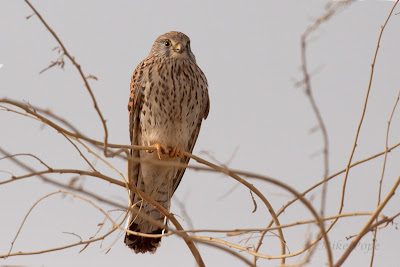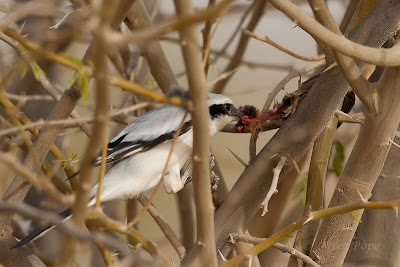I was up early to get to this oasis farm by 06h45, but being Spring Migration the shooters surrounding the farm had beat me to it. Nevertheless, I progressed into the farm - although it is difficult to relax and enjoy birding with the constant sound of gunfire with lead pellets raining down on your car. More concerning were those shooting with air rifles, as they shoot straight rather than up in the air, so it is best to keep your windows closed in case of a stray pellet.
I found this logo on a Flickr website, but I'm sure the person who posted it will encourage me using it, although it applies to shotguns too!
Just before turning off the tar road into the desert, I found a Steppe Eagle that had roosted overnight in the desert.
 |
| Steppe Eagle (Aquila nipalensis) |
What is quite amazing during migration is how since my last visit, species and numbers change. Today there were big numbers of Lesser Whitethroat
 |
| Lesser Whitethroat (Sylvia curruca) |
 |
| Male Eurasian Blackcap (Sylvia atricapilla) |
 |
| Pied Wheatear (Oenanthe pleschanka) |
 |
| Daurian Shrike (Lanius isabellinus) |
 |
| Turkestan Shrike (Lanius phoenicuroides) |
 |
| Tree Pipit (Anthus trivialis) |
 |
| Red-throated Pipit (Anthus cervinus) |
 |
| Tawny Pipit (Anthus campestris) |
 |
| Pale Rockfinch (Carpospiza brachydactyla) |
There were a few Accipiters about and I was fortunate to see both Eurasian Sparrowhawk, where I just missed the departing image getting the wingtip out of the frame - swinging The Beast is not always easy!
 |
| Male Eurasian Sparrowhawk (Accipiter nisus) |
and the much rarer and more sought after Shikra
 |
| Shikra (Accipiter badius) |
 |
| Common Redstart (Phoenicurus phoenicurus) |
 |
| Pallid Harrier (Circus macrourus) |
 |
| Spiny-tailed Lizard |





































